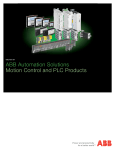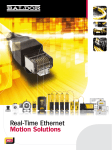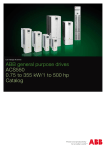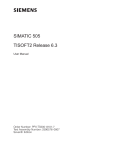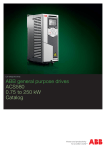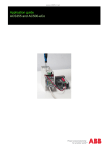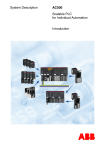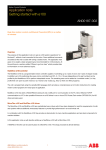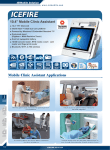Download AN00198-002 - ABB Motion Control
Transcript
Motion Control Products Application note Integrated Modbus support AN00198-002 Ready to use PLC function blocks, combine with pre-written Mint application for simple control of e100 drives via Modbus Introduction Integrated Modbus support has been introduced on the following ABB motion control products: NextMove ES/ESB-2 (Modbus RTU) – firmware version 5424 onwards NextMove e100 (Modbus RTU, Modbus TCP) – firmware version 5633 onwards MicroFlex e100 (Modbus RTU, Modbus TCP) – firmware version 5633 onwards MotiFlex e100 (Modbus RTU, Modbus TCP) – firmware version 5633 onwards New Mint keywords to enable and configure Modbus server operation have been added. Download firmware from www.abbmotion.com or contact [email protected] to obtain the relevant Mint System File (.msx) to update a drive / motion controller. Note that Modbus support is only offered on Revision B e100 products (e.g. MFE230A003B B). MicroFlex e150 drives support Modbus RTU and TCP as standard (with fixed mappings to Netdata) – please refer to the MicroFlex e150 user manual LT0291A01 for further details. Support is provided for the following Modbus functions: 03 – Read holding registers 04 – Read input registers 06 – Preset single register 16 – Preset multiple registers 23 – Read / write 4x registers A new Mint keyword (ModbusParameter) allows configuration of: Modbus enable Register mapping Byte order Word order Diagnostics The inclusion of integrated Modbus protocols on the listed controllers / drives allows connectivity between a wide range of ABB products including AC500 PLCs and CP600 HMIs as well as third party Modbus client devices. ABB Motion control products www.abbmotion.com 1 Application note Integrated Modbus support AN00198-002 Configuration Modbus RTU and TCP operation on e100 products is included with firmware update 5633 (or later). Modbus RTU operation on NextMove ES/ESB-2 requires firmware version 5424 (or later) or firmware version 5454 (or later) to be installed (depending on whether the user wishes to use Mint compiler target format 13 or 14 respectively). All Modbus parameters are configured via a new Mint keyword – ModbusParameter. Before enabling Modbus operation it is necessary to set the correct byte and word order to suit the connected Modbus client (master) and to configure how Modbus registers in the received data packets are mapped to internal data areas in the Mint controllers. value = ModbusParameter (bus, index) ModbusParameter (bus, index) = value Mint pre-defined constant values for bus are: _busETHERNET 5 For Modbus TCP parameters _busSERIAL1 6 For Modbus RTU parameters Index _mpENABLE _mpREGISTER_MAPPING _mpBYTE_ORDER _mpWORD_ORDER _mpDROPPED_FRAMES _mpDEBUG Value 0 1 2 3 6 7 0 = Disabled, 1 = Enabled 0 = NetData array (e100 default), 1 = Comms array (ESB-2 default) 0 = Big Endian (default), 1 = Little Endian 0 = Big Endian, 1 = Little Endian (default) Read only counter of number of invalid packets received Parameter used to display Modbus diagnostics Mint pre-defined constant values for _mpREGISTER_MAPPING are: _rmNET_DATA 0 To access netinteger / netfloat data _rmCOMMS_ARRAY 1 To access commsinteger / comms data NextMove ESB-2 is only provided with Comms array data so attempting to configure a Netdata register mapping on this controller will result in a ‘Data Out of Range’ error. The default byte and word orders are configured to match the majority of Modbus devices on the market today. However, ABB PLCs and CP600 HMIs use ‘Big Endian’ word order so when connecting Mint controllers to ABB Modbus clients it is necessary to include…ModbusParameter (bus, _mpWORD_ORDER) = 0…in the Mint startup block code. Modbus RTU is a serial based protocol and operation is supported using 8 data bits, 1 stop bit and no parity. The following baud rates are supported on all controllers: 19200 38400 57600 115200 Note that, due to timing constraints, 9600 baud is not supported. The baudrate to be used is set using the Mint SERIALBAUD(_Term1) keyword in the Mint program (or via the Mint Workbench ‘Connectivity’ page). As Modbus RTU packets include a node address it is also important to set the correct value for BUSNODE(_busSERIAL1) in the Mint program (or via the Mint Workbench ‘Connectivity’ page). Support is included for broadcast write functions (i.e. to Node address 0) so the user should avoid configuring a controller as Node 0 unless they intend to use broadcast functions. When using Modbus TCP the controllers / drives use the standard Modbus port 502. At present this port cannot be changed but provision to allow this port to be modified may be added in a future firmware release. The IP address used by Modbus TCP is set by the rotary address switches on the front of the e100 product; 192.168.100.x (where x is the switch setting). To enable Modbus server (slave) operation the Mint program should issue…. ModbusParameter (bus, _mpENABLE) = 1 (where bus = _busETHERNET for Modbus TCP or _busSERIAL1 for Modbus RTU). ABB Motion control products www.abbmotion.com 2 Application note Integrated Modbus support AN00198-002 Enabling Modbus RTU server operation automatically disables both Host Comms Protocol (HCP1/2) and ABB Binary Protocol (BBP) functionality on the serial port. Enabling Modbus RTU also prevents the controller from directing data from Mint PRINT statements to the serial port to avoid corruption of Modbus data packets. Register Mappings All supported Modbus functions target a common data area in the Mint controller as set by the Mint keyword ModbusParameter (_mpREGISTER_MAPPING). These data areas have a fixed mapping with respect to the Modbus registers on the server as shown by the table below (equivalent AC500 addresses are also shown for reference): Server Modbus AC500 address register 0 %MW0.0 1 %MW0.1 2 %MW0.2 3 %MW0.3 4 %MW0.4 5 %MW0.5 … --- 198 %MW0.198 199 %MW0.199 200 %MW0.200 201 %MW0.201 202 %MW0.202 203 %MW0.203 … --- 1996 %MW0.1996 1997 %MW0.1997 1998 %MW0.1998 1999 %MW0.1999 %MD0.0 %MD0.1 %MD0.2 --%MD0.99 %MD0.100 %MD0.101 --%MD0.998 Mint Comms array Mint Netdata array (Comms=Real, Commsinteger = DWord) (Netfloat = Real, Netinteger = DWord) Invalid Invalid Invalid Element 1 LSW Element 1 MSW Element 2 LSW Element 2 MSW --- Element 1 Element 2 Element 1 LSW Element 1 MSW Element 2 LSW Element 2 MSW --- Element 99 LSW Element 99 MSW Invalid Element 99 Invalid Invalid Invalid Invalid Invalid --- --Element 99 LSW Element 99 MSW Element 100 LSW Element 100 MSW Element 101 LSW Element 101 MSW --- Invalid Invalid Invalid Invalid %MD0.999 Element 0 LSW Element 0 MSW --Element 998 LSW Element 998 MSW Element 0 Element 1 Element 2 --Element 99 Element 100 Element 101 --Element 998 Element 999 LSW Invalid Invalid Element 999 MSW Element 999 LSW – Least Significant Word : MSW – Most Significant Word The Mint Comms array provides 99 elements (1-99). If the client attempts to access Comms element 0 or Comms elements greater than 99 the Mint controller will return the ‘Invalid Data Address’ Modbus exception packet. The Mint Netdata array (only supported on e100 products) provides 1000 elements (0-999). If the client attempts to access Netdata elements greater than 999 the Mint controller will return the ‘Invalid Data Address’ Modbus exception packet. Example Mint Code The following code snippets show typical Mint code that may be included in a controller / drive Startup block: Example Mint code – Mint Modbus RTU slave connected to AC500 or CP600 using Comms array BUSNODE(_busSERIAL1) = 2 ‘Mint controller is node 2 on RTU network SERIALBAUD(_Term1) = 57600 ‘Running at 57.6kbaud ModbusParameter (_busSERIAL1, _mpBYTE_ORDER) = 0 ‘Use big endian byte order ModbusParameter (_busSERIAL1, _mpWORD_ORDER) = 0 ‘Use big endian word order ModbusParameter (_busSERIAL1, _mpREGISTER_MAPPING) = _rmCOMMS_ARRAY ModbusParameter (_busSERIAL1, _mpENABLE) = 1 Example Mint code – Mint Modbus TCP slave connected to AC500 or CP600 using Netdata array ‘IP address is set by rotary switches….192.168.100.x ModbusParameter (_busETHERNET, _mpBYTE_ORDER) = 0 ‘Use big endian byte order ModbusParameter (_busETHERNET, _mpWORD_ORDER) = 0 ‘Use big endian word order ModbusParameter (_busETHERNET, _mpREGISTER_MAPPING) = _rmNET_DATA ModbusParameter (_busETHERNET, _mpENABLE) = 1 ABB Motion control products www.abbmotion.com 3 Application note Integrated Modbus support AN00198-002 Example Mint code – Mint Modbus RTU slave connected to third party Modbus client using little endian word order and Netdata BUSNODE(_busSERIAL1) = 4 ‘Mint controller is node 4 on RTU network SERIALBAUD(_Term1) = 38400 ‘Running at 38.4kbaud ModbusParameter (_busSERIAL1, _mpBYTE_ORDER) = 0 ‘Use big endian byte order ModbusParameter (_busSERIAL1, _mpWORD_ORDER) = 1 ‘Use little endian word order ModbusParameter (_busSERIAL1, _mpREGISTER_MAPPING) = _rmNET_DATA ModbusParameter (_busSERIAL1, _mpENABLE) = 1 For controllers / drives supporting both Ethernet and serial channels (e.g. NextMove e100, MicroFlex e100) it is possible to configure / enable Modbus TCP operation on Ethernet and at the same time configure / enable Modbus RTU operation on the serial port. Mint Events Mint events operate differently depending on the controller being used: NextMove ESB-2: Comms events will be raised whenever the Modbus client writes to Comms locations 1 to 5 (i.e. data does not necessarily have to change for an event to be raised). e100 products: Comms events will be raised whenever the Modbus client writes modified data to Comms locations 1 to 10(i.e. data must change for an event to be raised). Netdata events operate in the same manner and will only be raised whenever the Modbus client writes modified data to Netinteger / Netfloat locations 0 to 31. Physical Connection The table below shows the physical connection possibilities for Mint products supporting integrated Modbus protocols. AC500 and CP600 products are included for reference. Connection Type NextMove e100 NextMove ESB-2 MicroFlex MotiFlex e100 AC500 AC500 Eco CP600 e100 RS232 Yes Yes (by variant) No No Yes No Yes 2 wire RS485 No No Yes Yes Yes Yes Yes 4 wire RS422 Yes Yes (by variant) No No No No Yes Ethernet Yes No Yes Yes Yes Yes (by variant) Yes When using 2-wire RS485 be sure to include 120 ohm terminating resistors between data lines A and B at each end of the network to avoid data corruption. When using 4-wire RS422 be sure to include 120 ohm terminating resistors between RX+ and RX- at each end of the network to avoid data corruption. When using Modbus TCP / Ethernet, wire the network in a ‘star’ type configuration using an Ethernet switch between the client and the connected server(s). Straight-through or crossover cables may be used between the e100 device and the switch. If the e100 product is part of an Ethernet Powerlink (EPL) network then it is also necessary to include an EPL Router (Catalog No. OPT036-501) between the switch and the e100 device. Important: AC500 and CP600 products use a non-standard RS232 pinout so be sure to check the relevant product manual before connecting other serial devices to these products. Failure to observe the correct pinout may result in damage to the connected device. ABB Motion control products www.abbmotion.com 4 Application note Integrated Modbus support AN00198-002 Diagnostics The ModbusParameter keyword provides two types of diagnostics. A. Reading ModbusParameter (bus, _mpDROPPED_FRAMES) will return a counter indicating how many Modbus packets have been rejected (e.g. invalid checksum, incomplete message……in summary, any message for which neither a valid nor exception response has been generated) B Writing a terminal channel value to ModbusParameter (bus, _mpDEBUG) will reset diagnostic counters and setup which terminal channel is to be used to display diagnostic information. Reading ModbusParameter (bus, _mpDEBUG) will then return which terminal channel is being used for diagnostics and will display some summary information on the selected terminal channel (e.g. last packet received, last packet transmitted, error counters etc..) Example: ModbusParameter (_busETHERNET, _mpDEBUG) = _Term2 ? ModbusParameter (_busETHERNET, _mpDEBUG) If these commands were entered on a NextMove e100 the controller would display diagnostic information about Modbus TCP on the USB terminal (i.e. Workbench terminal window). Example debug output: Valid: 2 Dropped: 0. Exception: NO_EXCEPTION Rx: 8 bytes Node: 2 Fn code (hex): 03 Data (hex): 00 02 00 01 CRC (hex): f9 25 Tx: 7 bytes Node: 2 Fn code (hex): 03 Data (hex): 02 00 00 CRC (hex): 44 fc Note: Due to issues with the UART when using the 2 wire RS485 port on MicroFlex e100, every time the drive responds to a Modbus frame an additional null character is received internally. This is then interpreted as a dropped frame (invalid length) and the diagnostic information will reflect this. It is therefore recommended to only use the debug parameter for RS232 and Ethernet connections. Contact us For more information please contact your local ABB representative or one of the following: © Copyright 2012 ABB. All rights reserved. Specifications subject to change without notice. www.abbmotion.com www.abb.com/drives www.abb.com/drivespartners www.abb.com/PLC ABB Motion control products www.abbmotion.com 5





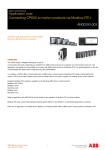
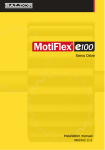

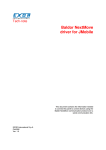
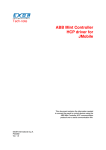
![*Sted Plus UG Jan 2012 [2].indd](http://vs1.manualzilla.com/store/data/005710511_1-f757ed41a0935df19f469c7cee361c5b-150x150.png)
